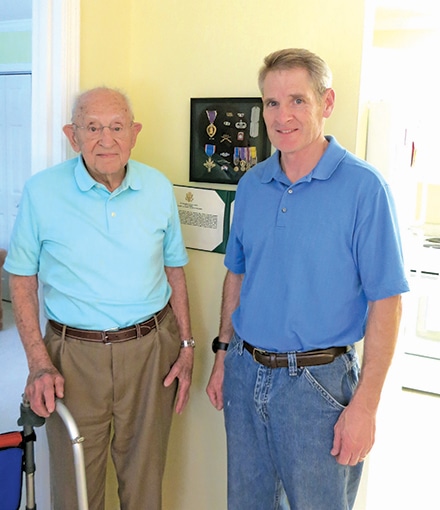
The Third Battalion was holding a front line position, and the ‘H’ Company was ordered to attack but ended up being surrounded by the enemy. The Lt. Colonel directed Hanna and his Machine Gun Platoon to lead a patrol to make a flanking attack on the Germans. After surveying the situation and coming up with an attack plan, Hanna led his group of 25 soldiers down the backside of a railroad track toward a house that held German snipers. Using stealth and strategic cover, they approached the house and threw grenades in killing two and wounding one.
They next headed toward a wooded area behind the house, and as Hanna was running down a hedge-row, a rabbit darted out in front causing him to pivot at the same time a bullet pierced his chest. “The bullet entered the upper part of my right chest in the same area that just a few minutes before I had a hand grenade hooked to my harness. Luckily I had used this grenade. The bullet entered my right chest, passed down through the right lung, and exited through the lower part of my lung; the bullet didn’t touch a bone.”
Hanna periodically fainted from the collapsed lung but eventually made it back to safety and their heroic actions allowed ‘H’ Company to escape back to their original line of defense. That action earned Hanna the Distinguished Service Cross and the Purple Heart.
Roy Hanna is my great uncle, the brother of my grandfather. He is 101 years old and has survived many of his relatives, a bullet to the chest, and 233 days of combat in World War II. He grew up in Pennsylvania and now lives in Pinehurst, NC. I had never met him and drove up there to meet, visit, and hear the stories of my great uncle, the brave WWII hero.
Known as the “Greatest Generation,” there were 16 million American soldiers that participated in WWII and only about 558,000, or less than 4%, remain. They are dying at an estimated rate of 372 each day. There were 291,000 killed in battle and 670,000 wounded during the conflict. These brave warriors gave their all for America, and the ones that survived the war are now being claimed by Father Time.
Roy Hanna has survived both so far and has lived to become a centenarian plus one. He had already graduated from Penn State with a degree in Food Science and was married when the war broke out. He volunteered at age 26 for a year and ended up staying five years. After starting out in the National Guard, he volunteered to join the paratroopers to get out of the guard. He went to Officer’s Candidate School at Fort Benning, Georgia.
From October 1942 to the end of the war, Hanna was involved in five combat missions. He made two jumps into enemy territory as a paratrooper, the first one being in Sicily at night as anti-aircraft guns blazed away at them. In February 1944, 82nd Airborne invaded Anzio, Italy where Hanna was shot and earned his Distinguished Service Cross.
In a military hospital, Hanna recuperated which included inserting a syringe to extract fluid out of his lungs. By March, he was in England getting ready for the next campaign called Market Garden, an invasion into the Netherlands to secure roads and bridges for more advancing troops. This campaign was told in the 1977 movie, ‘A Bridge Too Far.’ Hanna’s part was crossing the Waal River in canvas boats under enemy fire.
After surviving that mission, he was sent home for a rest and got to see his 17-month old daughter for the first time. He rejoined his unit later to participate in clearing up areas from Cologne to Hanover, Germany till the end of the war.
Roy Hanna, the youngest of eleven children, went on to have a career in the dairy field, fathered four children, and retired at age 75. Two years ago the Queen Maxima of the Netherlands visited America and requested to see soldiers who helped liberate the Netherlands and Roy attended. At Fort Bragg, the 82nd Airborne has a command room called the “Roy Hanna Room.”
Hanna has lived a long amazing life including defending our county in World War II, and I’m proud to be related to him.

